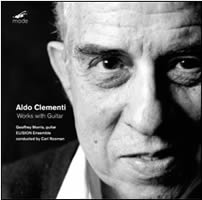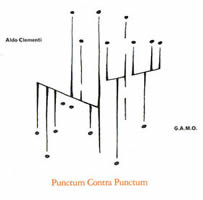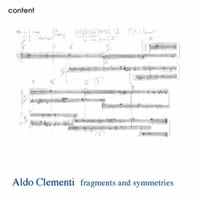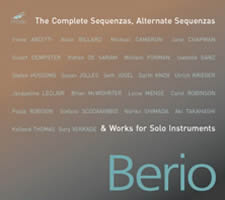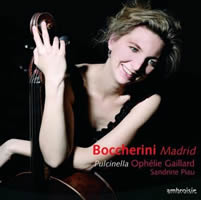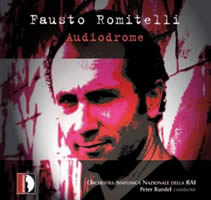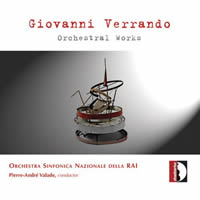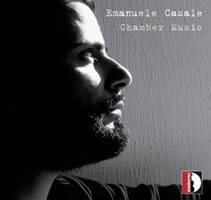Italian Vacation 7.
|
Grant Chu Covell [March 2009.]
“Works with Guitar.” Aldo CLEMENTI: Serenata (1988); Dodici Variazioni (1980); Albumblatt (1995); Fantasia su frammenti di Michelangelo Galilei (1978); Otto Variazioni (2002); C.A.G. (1993); The Plaint (1992). Geoffrey Morris (guit); ELISION Ensemble, Carl Rosman (cond.). mode 182 (http://www.moderecords.com/). “Punctum Contra Punctum.” Aldo CLEMENTI: Concerto (1986); GiAn(ca)rlo CArDini (1978); Fantasia su roBErto FABbriCiAni (1980/81); Parafrasi (1981). Giancarlo Cardini (pno), Roberto Fabbriciani (fl), Liliana Poli (sop); Gruppo Musica Contemporanea di Firenze, Mario Ruffini (cond.). Die Schachtel DS12 (http://www.die-schachtel.com/). “fragments and symmetries.” Aldo CLEMENTI: Invenzione 4 (2003); three versions of Studio (sul tocco) (1993); B.A.C.H. (1970); two versions of Blues (Fantasie su frammenti di Thelonious Monk) / Blues 2 (2001); Replica (B.A.C.H.) (1972); Vom Himmel hoch (1999); Variazioni (1999); Turmuhr (1995); Frammento (1983); Invenzione 2 (2002); Danze (1989); Madrigale (1979); Composizione N. 1 (1957); Studio 2 (sulla monotonia) (2004); Variazioni su B.A.C.H. (1984); GiAn(ca)rlo CArDini (1978); Loure (1998); Sarabande (1946); Catene simmetriche (2004). Mats Persson, Kristine Scholz, Ulrica Holmberg, Luciana Marques, Christian Rosenberg, Benedikte Weinreich, Aldo Clementi (pnos), Jonny Axelsson (perc). Content SAK 4610-9 (2CDs) (http://www.content-records.se/). Some Clementi pieces slow the pulse and compel contemplation. Others fly by like white-water rapids. The Catania-born composer plays with canons, collage and repetition to create patterned textures lit with subdued light. Irony touches on most everything he writes. On the mode disc, the Serenata for guitar with flute, clarinet, violin and viola illustrates Clementi’s disarming aesthetic. The same music is played three times, each time quieter and slower. Whereas most composers deliver builds and climaxes, Clementi coordinates fade-outs and decays. Sometimes canons loop with subtle changes. This isn’t to say that every Clementi piece sounds like an extinguishing music box. There’s plenty of bounce and grit in the solo Dodici Variazioni. Clementi’s employment of collage in the charismatic Fantasia su frammenti di Michelangelo Galilei (brother to Galileo) knits together gestures from a 1620 lute primer to create chromatic arcs. Clementi works in variable dimensions: from the five-minute C.A.G. for flute, vibraphone, violin and guitar with its slow, dolorous canonic evaporation to the disc’s closer, the 16:23 The Plaint, with its 13-strong ensemble, which simply wastes away. All but the Dodici Variazioni and the Fantasia are first recordings. Hats off to mode. The attractive Die Schachtel release (in a paperboard box with a 56-page, illustrated booklet) captures a 1987 concert in the Sala Brunelleschi, Florence. The Concerto for piano and 14 instruments creates a rotating mobile effect as each player repeats material derived from Schumann’s eighth Novelletten Op. 21, albeit rendered as unrecognizable. Played for prepared piano by its dedicatee, GiAn(ca)rlo CArDini sounds like a mistracking Nancarrow etude: Seven canonic parts revolve around the musical pitches in Cardini’s name; the player must also sing a Gershwin refrain. As Clementi’s note for Fantasia su roBErto FABbriCiAni describes, the canonic flutes on tape surround the flute soloist “like an enormous growth of vegetation that chokes out a little plant.” Parafrasi applies similar processes to a solo soprano voice using a computer to create an obsessive elaboration of small motives. The more relaxed “fragments and symmetries” opens onto a Clementi piano galaxy. Adding glockenspiel and vibraphone, Madrigale demonstrates Clementi’s characteristic wind-down. Exploring the opening notes of Tchaikovsky’s Piano Trio, the single-piano four-hand Frammento similarly extinguishes itself. As with Nancarrow player-piano studies, the three canonic B.A.C.H. pieces peer into machine internals. Replica (B.A.C.H.) adds delicate preparation, completing the illusion. The Blues & Blues 2 confabulate a different piano style, both recognizable and not. Turmuhr and Vom Himmel hoch build churning Satie-like maypoles from the same Lutheran tune. Other Satie touches hover in Invenzione 4. The composer performs the collection’s earliest piece, the 1946 Sarabande. Masterfully played by duo-pianists Persson and Scholz, the 31-minute Catene simmetriche plays out as a sparse, autumnal series of eight canons, its melodic fragments just barely familiar.
“Sequenzas I – XIV.” Luciano BERIO: Sequenza I (1958); Sequenza II (1963); Sequenza III (1965-66); Sequenza IV (1966); Sequenza V (1965); Sequenza VI (1967); Sequenza VIIa (1969); Sequenza VIII (1976); Sequenza IXa (1980); Sequenza X (1984); Sequenza XI (1987-88); Sequenza XII (1995); Sequenza XIII, “Chanson” (1995); Sequenza XIV (2002); Sequenza VIIb (1995); Sequenza IXb (1981). Nora Shulman (fl), Erica Goodman (hp), Tony Arnold (sop), Boris Berman (pno), Alain Trudel (trb), Steven Dann (vla), Matej Šarc (ob), Jasper Wood (vln), Joaquin Valdepeñas (clar), Guy Few (trpt), Pablo Sáinz Villegas (guit), Ken Munday (bsn), Joseph Petric (accordion), Darrett Adkins (vlc), Wallace Halladay (sop sax, alto sax). Naxos 8.557661-63 (3CDs) (http://www.naxos.com/). “Complete Sequenzas, Alternate Sequenzas & Works for Solo Instruments.” Luciano BERIO: Sequenza I (1958); Sequenza II (1963); Sequenza III (1965-66); Sequenza IV (1966); Sequenza V (1965); Sequenza VI (1967); Sequenza VIIa (1969); Sequenza VIII (1976); Sequenza IXa (1980); Sequenza IXb (1981); Sequenza X (1984); Sequenza XI (1987-88); Sequenza XII (1995); Sequenza XIII, “Chanson” (1995); Sequenza XIVa (2002); Sequenza VIb (1981); Sequenza VIIb (1995); Sequenza IXc (1980); Sequenza XIVb (2004); Rounds (1964-65); Gesti (1966); Fa-Si (1975); Les mots sont allés… (1978); Lied (1983); Comma (1987); Psy (1989); Chanson pour Pierre Boulez (2000); Gute Nacht (1986). Paula Robison (fl), Susan Jolles (hp), Isabelle Ganz (mez-sop), Aki Takahashi (pno), Stuart Dempster (trb), Garth Knox (vla), Jacqueline Leclair (ob), Irvine Arditti (vln), Carol Robinson (clar, e-flat clar), Kelland Thomas (alto sax), William Forman (trpt), Seth Josel (guit), Noriko Shimada (bsn), Stefan Hussong (accordion), Rohan de Saram (vlc), Ulrich Krieger (sop sax), Alain Billard (b-clar), Stefano Scodanibbio (cbs), Jane Chapman (hpsi), Lucia Mense (recorder), Gary Verkade (org), Michael Cameron (cbs), Brian McWhorter (trpt). mode 161/163 (4CDs priced as 3) (http://www.moderecords.com/). Among experiences which have long remained in memory is violinist Carlo Chiarappa’s electrifying performance of Sequenza VIII following one of Berio’s Norton Lectures (October 20, 1993). Chiarappa dug into the Sequenza’s opening A’s before the introductory applause subsided. Months later (March 2, 1994) during the oboe Sequenza VII, I remember Berio fussing with a dial to change the accompanying B-natural drone’s dynamic. There was a time when DG’s then-complete Sequenzas release (DG 457 038-2) was the presumptive choice. Since then, Berio wrote a 14th and adapted others for different instruments. While Naxos and mode both released complete sets (both claim Sequenza XIV’s first recording), mode takes the prize for thoroughness. Mode’s four discs include all 14 Sequenzas, the alternate Sequenzas (arrangements for similar instruments), Berio’s other solo pieces (except the works for solo piano), and the verses Edoardo Sanguineti created for each Sequenza. You can of course skip over the spoken moments but they do link the solos, thus strengthening their multi-decade span. As each is a substantial solo, some may prefer to audition them one at a time. In addition to the 14, Naxos provides just two alternates, VIIb (soprano sax) and IXb (alto sax). Unlike the Naxos set which was recorded at the same location in Ontario, Canada, between 1998 and 2004, mode’s tapings occurred at various locations between 1995 and 2006. Here again Enzo Salomone’s dramatic Sanguineti continuity obscures the locales’ differences. Naxos’ slim 12-page booklet provides essential details. Mode designed a box, individual cardboard sleeves for the four discs, and a 104-page booklet with pictures and extensive notes. Besides Sequenza XIV, mode offers other first recordings. Now for the tough work. I had thought to do an apples-to-apples comparison of the 16 pieces; however, such a strategy proved unwieldy, especially as it became clear that mode has the advantage. Obsessives will need both releases, along with the 1998 DG set. Those who have sought out premiering performances probably own Gazzelloni (I) on col legno WWE 1CD 31894, Berberian (III) and Holliger (VII) on Philips 426 662-2, Chiarappa (VIII) on Denon CO-75448, and Fisk (XI), Gallois (XII) and Anzellotti (XIII) on the DG set. Continuing that same logic, mode’s recording of Dempster (V) and de Saram (XIV) are must-haves. High among mode’s alternates are Scodanibbio playing his contrabass arrangement of the cello Sequenza. Mode’s greater abundance leaves one with the impression of having heard encores: De Saram plays the tidbits Les mots sont allés… and Chanson pour Pierre Boulez plus the violist’s VI arranged for cello. Robinson reprises her clarinet’s supple sound in the short Lied and even tinier Comma. The oboe Sequenza’s drone employs three women’s voices instead of the customary sine wave. The snappy mid-Sixties harpsichord Rounds and recorder Gesti both sound electronic as well as contemporaneous with the extended techniques required for the female voice in Sequenza III. Naxos standouts include Arnold in III and Dann in VI. I prefer a high female voice in III — Arnold’s voice seems higher than Berberian’s — and mode’s Ganz sounds too low.
Luigi BOCCHERINI: Fandango from the Quintet, G448 (1798); Concerto for cello and orchestra in D major, G483 (1782); Aria accademica “Se d’un amor tiranno” (ca. 1780); Concerto for cello and orchestra in G major, G480 (1770). Ophélie Gaillard (vlc), Sandrine Piau (sop), Rolf Lislevand (guit), Pulcinella, Ophélie Gaillard (dir.). Naïve AM 126 (1CD and 1 DVD) (http://www.naive.fr/). Distributed in the US by Naxos (http://www.naxos.com/). Gaillard and Pulcinella send the dust flying with this invigorating Boccherini release. The boisterous Fandango with guitars and castanets opens the program. Hard to believe this work has its roots in 1798. The quarter-hour length and repeating chord progression suggest a bit of improvisation in the central section (which one of the associated films on DVD confirms). Gaillard leads in two bright cello concertos with impassioned slow movements that straddle Vivaldian Baroque, Haydn and early Mozart. An elegant Piau joins concertante cello and orchestra in the Aria accademica, another bright early-Classical gem. Boccherini reused the aria in a cello sonata. Throughout, Gaillard projects a silvery tone that answers Boccherini’s demands for stratospheric technique. Guitar and fortepiano provide continuo. Two documentaries on the DVD: the 23-minute Neiges éternelles (Eternal Snow, i.e., the fingerboard’s highest reaches where the strings lie under a dusting of the bow’s rosin), in which Gaillard talks about Boccherini’s ranging abilities from his Stabat Mater to the Fandango, and the 24-minute Parfums de Madrid, which centers around the Fandango’s recording session.
Fausto ROMITELLI: Dead City Radio. Audiodrome (2003); EnTrance (1995); Flowing down too slow (2001); The Nameless City (1997). Donatienne Michel-Dansac (sop), Orchestra Sinfonica Nazionale della RAI, Peter Rundel (cond.). Stradivarius STR 33723 (http://www.stradivarius.it/). Distributed in the US by Allegro Music (http://www.allegro-music.com/). More music from the end of the world, from a composer who was not on this one long enough. For Dead City Radio. Audiodrome, Romitelli blends noise and grunge with symphony orchestra. Amplifier feedback, electric guitars and the white noise of cymbals intrude upon a distorted Strauss quote. The sluggish blurred textures and blaring wisps from An Index of Metals (2003) dwell here as well, over static harmonies. In EnTrance, employing texts from the Tibetan Book of the Dead, Michel-Dansac squirms over chamber ensemble and electronics. It surprises that a composer who leaned towards electronics would write so effectively for string ensemble. Part of Romitelli’s effectiveness was his understanding of sonority and balance, so that the strings in Flowing down too slow and The Nameless City layer complex chords built from particular overtone series or use extensive divisis to create textural blocks that heave and subside.
“Donatoni Edition VI.” Franco DONATONI: Algo IV (1996); Poll (1998); Refrain IV (1996); About (1979); Al (1997); Small II (1993); Algo (1977). Stefano Cardi (guit), Freon Ensemble, Stefano Cardi (cond.). Stradivarius STR 33773 (http://www.stradivarius.it/). Distributed in the US by Allegro Music (http://www.allegro-music.com/). With their characteristic late-period stridency and machine-gun rhythms, six of these seven Donatoni pieces include guitar. Small II for flute, viola and harp is the exception. The two-part Algo for solo guitar stems from a Django Reinhardt fragment. Decades later, three more works centering on guitar would be sparked from it. Included here is Algo IV for solo guitar with ensemble of percussion, vibraphone, marimba, xylophone, mandolin, harpsichord, piano, celesta, violin, viola, cello and bass. The opening salvo with prominent harpsichord and celesta sounds electronic. Most of these works have bright tessituras, rich with instruments that pluck: Refrain IV for mandolin, guitar, harp, harpsichord, celesta, piano, vibraphone and marimba, Al, dedicated to fellow composer Alessandro Melchiorre, for mandolin, mandola and guitar, and Poll, dedicated to Pollini, for mandolin, mandola, guitar, harp, piano, celesta, harpsichord, vibraphone, marimba, violin, viola, cello and bass. The harpsichord imparts an unexpected color, reminiscent of late-’60s B-movie scores, and perhaps because of the more transparent scoring, I heard patterns and chords common to Messiaen. About begins mysteriously, with nasal and scratchy sounds that mask its violin, viola and guitar combination. One of the most interesting releases to come out in Stradivarius’ Donatoni Edition.
Giovanni VERRANDO: Triptych (2005-06); Sottile (1996-97); Agile (2004); Polyptych (2007). Orchestra Sinfonica Nazionale della RAI, Pierre-André Valade (cond.). Stradivarius STR 33788 (http://www.stradivarius.it/). Distributed in the US by Allegro Music (http://www.allegro-music.com/). Emanuele CASALE: 9 (2005); Studio 2a (1998); Studio 1 (1997); Composizione per cinque strumenti (1998); 5 (2003); Composizione per voce (1997); 3 (2002); Composizione per quattro (1999). Icarus Ensemble, Giorgio Bernasconi (cond.); Ex Novo Ensemble. Stradivarius STR 33750 (http://www.stradivarius.it/). Distributed in the US by Allegro Music (http://www.allegro-music.com/). Retrospect can tease history into simple troughs, but it’s clear that Romitelli and Lang have made distinctive impressions upon their colleagues and the younger generation. I can’t think Verrando and Casale would be doing what they’re doing if it weren’t for the pop- / jazz-influenced work of Romitelli and Lang. I had to set aside the program notes for the Verrando release. They overinflate the composer’s intentions and distract from the compelling sounds. Certainly, the movement titles can confuse. Polyptych’s four movements are filtering #4, musikplastik, filtering #4.1 and heterophonic #5. Verrando blends orchestra with electronics, each mimicking the other. Charting this Donatoni and Murail student’s growth indicates that his methods have become more subtle. Sottile balances recordings against live ensemble, whereas the recent Triptych and Polyptych fuse electronic noise with similar percussion sounds. Elsewhere high-stringed ponticello warbles with tapes. Now and again, an electric guitar or rock beat’s jab will shake things up. Casale’s fidgety works build from small bursts. The composer also employs silence and repetition (looped motifs, equally spaced percussion or chords) as cadences or arrival points. Many works use electronics or tape (never apparent from the titles or the track descriptions) which jiggle sounds similar to the accompanying instruments, seasoned with distortion and grunge. Simulating a DJ’s scratching, the most recent and potent composition, 9 (seven players plus tape), pushes beyond an electric-Donatoni. As the longest work, Casale’s frenetic techniques extend the miniatures Studio 2a (bass flute with tape), Studio 1 (horn and tape), and 3 (flute and bassoon). Textless voice appears in Composizione per quattro (flute, trombone, voice, percussion and tape) and of course in Composizione per voce, for solo voice.
[More Grant Chu Covell, Italian Vacation]
[Previous Article:
Dowland Our Contemporary: String Quartets]
[Next Article:
Piano Factory 4.]
|
